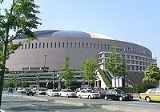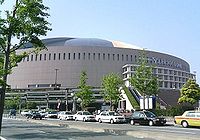
Oshima Shipbuilding
Encyclopedia
Oshima Shipbuilding Co., Ltd. is a privately held
Japan
ese shipbuilding
company. The company was founded on February 7, 1973 and began operations in June 1974. It is a joint venture
between Sumitomo Corporation
, Sumitomo Heavy Industries
, and the Daizo Corporation.
and panamax
bulk carrier
s.
The company has built 400 bulk carriers and delivers about 25 new ships annually to a worldwide client base. As of 2003, the company has annual revenues of 61,900,000,000 Yen and a staff of 975 full time employees. An additional 660 workers work for Oshima on a subcontracting basis.
 The company specializes in building bulk carrier
The company specializes in building bulk carrier
s. It has a number of standard designs, featuring bulkers with capacities from to in the handysize
, handymax
, and panamax
size classes. The company also has a line of specialized coal carriers with capacities from to . Some of the handymax-sized vessels have optional open and semi-open hatch configurations.
The company provides three hull options: single-hull, double-hull, and its own proprietary "Hy-Con" or hybrid hull configuration. Single hulls are available on the smallest and largest of the vessels. Double hulls are available on the smallest and all vessels from to . The Hy-Con configuration is available on ships in the to range.
The Hy-Con design was developed to increase safety and the efficiency of cargo handling on bulkers. This design starts as a standard single-hulled ship. Then, the forward and aft holds are built up to double-hull structures.
Oshima has built a number of other types of ships. The list includes self-unloading bulkers, wood-chip carriers, car carriers, oil tanker
s, and submersible heavy-lift vessels. The company has also built other large structures, including the Oshima Bridge and the Fukuoka Dome
.
Private company limited by shares
A private company limited by shares, usually called a private limited company , is a type of company incorporated under the laws of England and Wales, Scotland, that of certain Commonwealth countries and the Republic of Ireland...
Japan
Japan
Japan is an island nation in East Asia. Located in the Pacific Ocean, it lies to the east of the Sea of Japan, China, North Korea, South Korea and Russia, stretching from the Sea of Okhotsk in the north to the East China Sea and Taiwan in the south...
ese shipbuilding
Shipbuilding
Shipbuilding is the construction of ships and floating vessels. It normally takes place in a specialized facility known as a shipyard. Shipbuilders, also called shipwrights, follow a specialized occupation that traces its roots to before recorded history.Shipbuilding and ship repairs, both...
company. The company was founded on February 7, 1973 and began operations in June 1974. It is a joint venture
Joint venture
A joint venture is a business agreement in which parties agree to develop, for a finite time, a new entity and new assets by contributing equity. They exercise control over the enterprise and consequently share revenues, expenses and assets...
between Sumitomo Corporation
Sumitomo Corporation
Sumitomo Corporation is one of the largest worldwide trading company , and is a diversified corporation. Sumitomo is headquartered in the Harumi Island Triton Square Office Tower Y in Chūō, Tokyo, Japan...
, Sumitomo Heavy Industries
Sumitomo Heavy Industries
Sumitomo Heavy Industries, Ltd. is an integrated manufacturer of industrial machinery, automatic weaponry, ships, bridges and steel structure, equipment for environmental protection, including recycling, power transmission equipment, plastic molding machines, laser processing systems, particle...
, and the Daizo Corporation.
History
Oshima launched its first ship in 1975. The disruptions in the oil industry of the 1970s caused the company difficulties. Between 1975 and 1979 Oshima reduced its workforce from 1,800 to 785. In response, the company repositioned itself to specialize in building handymaxHandymax
Handymax and Supramax are naval architecture terms for a bulk carrier,in a series that is called Handysize class. Handysize class consists of Supramax , Handymax , and Handy Handymax and Supramax are naval architecture terms for a bulk carrier,in a series that is called Handysize class. Handysize...
and panamax
Panamax
Panamax and New Panamax are popular terms for the size limits for ships traveling through the Panama Canal. Formally, the limits and requirements are published by the Panama Canal Authority titled "Vessel Requirements"...
bulk carrier
Bulk carrier
A bulk carrier, bulk freighter, or bulker is a merchant ship specially designed to transport unpackaged bulk cargo, such as grains, coal, ore, and cement in its cargo holds. Since the first specialized bulk carrier was built in 1852, economic forces have fueled the development of these ships,...
s.
The company has built 400 bulk carriers and delivers about 25 new ships annually to a worldwide client base. As of 2003, the company has annual revenues of 61,900,000,000 Yen and a staff of 975 full time employees. An additional 660 workers work for Oshima on a subcontracting basis.
Products

Bulk carrier
A bulk carrier, bulk freighter, or bulker is a merchant ship specially designed to transport unpackaged bulk cargo, such as grains, coal, ore, and cement in its cargo holds. Since the first specialized bulk carrier was built in 1852, economic forces have fueled the development of these ships,...
s. It has a number of standard designs, featuring bulkers with capacities from to in the handysize
Handysize
Although there is no official definition in terms of exact tonnages, Handysize most usually refers to a dry bulk vessel with deadweight of about 15,000–35,000 tons...
, handymax
Handymax
Handymax and Supramax are naval architecture terms for a bulk carrier,in a series that is called Handysize class. Handysize class consists of Supramax , Handymax , and Handy Handymax and Supramax are naval architecture terms for a bulk carrier,in a series that is called Handysize class. Handysize...
, and panamax
Panamax
Panamax and New Panamax are popular terms for the size limits for ships traveling through the Panama Canal. Formally, the limits and requirements are published by the Panama Canal Authority titled "Vessel Requirements"...
size classes. The company also has a line of specialized coal carriers with capacities from to . Some of the handymax-sized vessels have optional open and semi-open hatch configurations.
The company provides three hull options: single-hull, double-hull, and its own proprietary "Hy-Con" or hybrid hull configuration. Single hulls are available on the smallest and largest of the vessels. Double hulls are available on the smallest and all vessels from to . The Hy-Con configuration is available on ships in the to range.
The Hy-Con design was developed to increase safety and the efficiency of cargo handling on bulkers. This design starts as a standard single-hulled ship. Then, the forward and aft holds are built up to double-hull structures.
Oshima has built a number of other types of ships. The list includes self-unloading bulkers, wood-chip carriers, car carriers, oil tanker
Oil tanker
An oil tanker, also known as a petroleum tanker, is a merchant ship designed for the bulk transport of oil. There are two basic types of oil tankers: the crude tanker and the product tanker. Crude tankers move large quantities of unrefined crude oil from its point of extraction to refineries...
s, and submersible heavy-lift vessels. The company has also built other large structures, including the Oshima Bridge and the Fukuoka Dome
Fukuoka Dome
The is a baseball field, located in Chūō-ku, Fukuoka, Japan. Built in 1993, the stadium can accommodate 35,695 spectators and was Japan's first stadium with a retractable roof....
.
External links
- Vessels Built list at Det Norske Veritas
- Shipyard at WikiMapia
- Risk Assessment of Double-Skin Bulk Carriers analyzes the Hy-Con design

